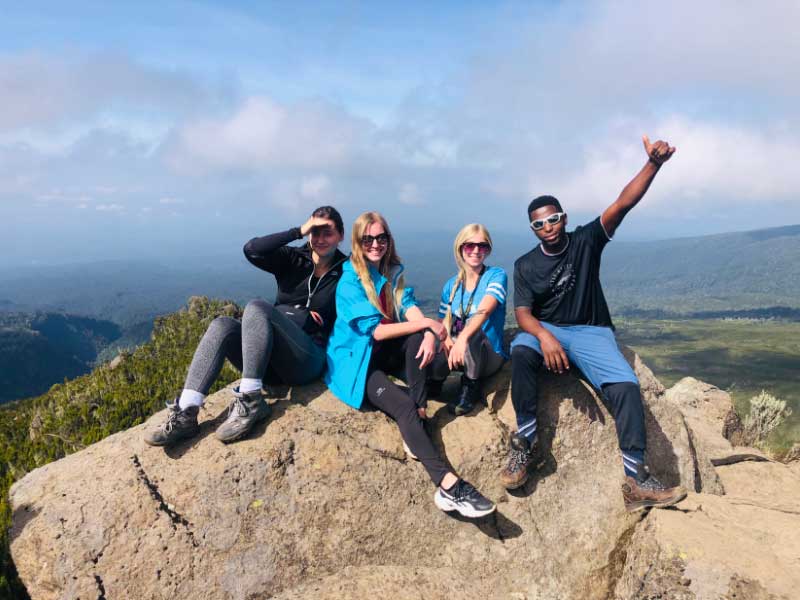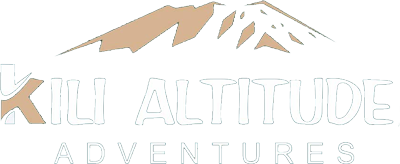Preparation For Kilimanjaro Trek
- Home
- Kilimanjaro Climb Tips
How Do I Prepare to Climb Kilimanjaro?
This section covers what gear you need to bring, physical training, Tanzania entry requirements (passport & visa), immunizations and vaccinations, and travel insurance.
What Gear Do I Need to Bring?
You are responsible for bringing personal gear and equipment while communal equipment (tents, food, cooking items, etc.) is provided. Below is a gear list of required, recommended, and optional items to bring on your climb.
Technical Clothing
1 – Waterproof Jacket, breathable with hood
1 – Insulated Jacket, synthetic or down, warm
1 – Soft Jacket, fleece or soft-shell
3 – Long Sleeve Shirt, light-weight, moisture-wicking fabric
1 – Short Sleeve Shirt, light-weight, moisture-wicking fabric
1 – Waterproof Pants, breathable (side zipper recommended)
2 – Hiking Pants
1 – Fleece Pants
1 – Shorts (optional)
1 – Long Underwear, moisture-wicking fabric
4 – Underwear, moisture-wicking fabric recommended
3 – Sports Bra (women)
Headwear
1 – Brimmed Hat, for sun protection
1 – Knit Hat, for warmth
1 – Balaclava or Buff (recommended)
Handwear
1 – Gloves, warm (waterproof recommended)
1 – Gloves, light
Footwear
1 – Hiking Boots or Shoes, warm, waterproof
4 – Socks, wool or synthetic
1 – Gaiters, waterproof (optional)
Accessories
1 – Sunglasses Sunglasses or Goggles
1 – Backpack Cover, waterproof (optional)
1 – Water Bottle (Nalgene, 32 oz.)
1 – Water Bladder (Camelbak type, 3 liters)
1 – Towel, lightweight, quick-dry (optional)
1 – Pee Bottle, to avoid leaving tent at night (recommended)
Stuff Sacks, Dry Bags, or “Ziploc”-Type Plastic Bags, to keep gear dry and separate. Note that there is a general ban on plastic bags in Tanzania, however, Ziploc-type bags for toiletries are permitted for tourists.
Equipment
1 – Sleeping Bag, warm, four seasons*
1 – Camp Pillow, inflatable (optional)
1 – Trekking Poles, collapsable (highly recommended)*
1 – Head Lamp, with extra batteries
1 – Duffel Bag, 70L-90L capacity, for porters to carry your equipment
1 – Daypack, 30-35L capacity, for you to carry your gear
*maybe rented on location
Other
Toiletries
Prescriptions
Sunscreen
Lip Balm
Insect Repellent, containing DEET
First Aid Kit
Face Mask
Hand Sanitizer
Toilet Paper
Wet Wipes (recommended)
Snacks, light-weight, high calorie, high energy (optional)
Electrolytes, powder, or tablets (optional)
Camera, with extra batteries (optional)
Paperwork
Trip Receipt
Passport
Visa (available at JRO)
Immunization Papers
Insurance Documents
Should I Get a Medical Check-Up?
All climbers should have a medical check before attempting the mountain. Ask your doctor if high-altitude trekking is permissible for your age, fitness level, and health condition. Ask if you have any preexisting medical conditions that can cause problems on the climb. Ask if any of your medications can affect altitude acclimatization. Ask whether Diamox can be taken with your existing prescription medicines.
If you have any medical issues that can make climbing Kilimanjaro more dangerous for you than the average person, we need to be informed of this before you book.
Such medical issues include but are not limited to: spine problems; circulation problems; internal problems such as diabetes, hypoglycemia, intestinal or kidney problems; respiratory issues such as asthma; high or low blood pressure; head trauma or injury; heart conditions; blood disease; hearing or vision impairment; cancer; seizure disorders; joint dislocations; sprains; hernia.
The minimum age for climbing Mount Kilimanjaro is 10 years old. There is no maximum age. However, the climb is strenuous and presents health risks, especially to people in high-risk categories. Serious consideration should be given to anyone under the age of 18 and over the age of 60. The climbers on the extreme ends of the age spectrum should consult their doctor.
Our minimum fitness requirements are that each climber must have a resting heart rate of under 100 beats per minute. We will check your resting heart rate before your climb. If your resting heart rate is above 100, you will be required to see a local doctor before the climb to get approval. The average resting heart rate is 60-80 beats per minute.
How Can I Prepare for High Altitude?
Getting your body in great shape through physical training certainly helps prepare you for altitude. However, the ability to adjust quickly to the changing oxygen content is largely genetic. As the Kilimanjaro climbing success rates show, some people can climb Kilimanjaro in as little as 5 days (not recommended), while some still fail within 8 days. It is impossible to tell how well a prospective climber may fare in an oxygen-deprived atmosphere until he or she is actually in it.
High altitude training systems enable climbers to pre-acclimatize at home, drastically improving the success rate, safety, and enjoyment of the climb.
Altitude training systems simulate high altitudes to induce beneficial biological adaptations in the body. Besides going to (and staying in) high altitude places, using a high altitude training system is the only way to pre-acclimatize to high altitude before your trip.
How do I Train to Climb Kilimanjaro?
Climbing Mount Kilimanjaro is a physical undertaking, so you should prepare yourself accordingly with a Kilimanjaro training program. Being in good shape is important in many respects. Strong, conditioned legs make it easier to walk uphill and downhill for sustained periods. General aerobic fitness allows the body to function efficiently with less oxygen. And a fit body is more likely to withstand the stress of consecutive days of hiking and camping. Finally, a positive mental attitude can work wonders for you when fatigue and doubts arise.
How hard is it to climb Kilimanjaro? That’s a difficult question to answer because some people don’t train much and fare very well, while others engage in a disciplined training program and succumb to the altitude in a few days. We’ve heard marathon runners tell us that climbing Kilimanjaro is the hardest thing they’ve ever done. The best advice we can give is to train adequately, as described below, and get yourself in the best possible hiking shape. The mountain is a big unknown, and you won’t know with certainty how you will react until you are there. In a survey we administered, on a scale of 1 (easy) to 10 (difficult), respondents rated their climb with an average difficulty of 7 (see Can an Unfit Person Climb Mount Kilimanjaro?).
The best exercise that you can do to prepare for Mount Kilimanjaro is hiking.
There are training regimens on other operators’ sites that entail strict, extensive, cross-training programs, featuring hiking, running, biking, swimming, weight training, etc. Do not be alarmed by this. Those programs are excessive and unnecessary. To sufficiently prepare for climbing Kilimanjaro, the best and perhaps only exercise you need to do is to hike – period. After all, that is what you will be doing on the mountain. Ideally, you should try to hike as much as possible on hills or mountains to simulate climbing Mount Kilimanjaro. Doing day hikes is superb training. For those who do not have access to trails, the next best option is to train on stairs. You can also train very productively on a stair master machine. As a last resort, walk as much as you can, with extended walks on the weekends.
You should start training for climbing Kilimanjaro at least two months before your departure.
If you’ve never hiked before, you should start with shorter time intervals, a slower pace, and no weight (in your day pack), and then gradually increase all of the above as your fitness level improves. Remember that on Mount Kilimanjaro, you will walk slowly for prolonged periods, and carry probably no more than 20 lbs in your day pack. Therefore, in your training, it is better to increase the time interval/distance and keep a slow pace than to shorten the time interval/distance and increase the pace. Try to train three times a week, for at least one hour per session, at a minimum. If you can do day hikes for four to six hours, with moderate elevation changes (~1,000 ft/305 m) while carrying a 20 lb pack, or if you can climb stairs or use a StairMaster for 1-2 hours, at 30 steps per minute while carrying a 20 lb pack, then you’re probably ready for the real thing.
Your longest/hardest workouts should be performed two to four weeks before your departure. For the last two weeks, you should taper off your training and in the final days, rest so that your body has time to recover before your actual climb. In addition to walking/hiking, you can also supplement your training with exercises such as running or cycling, which will increase your aerobic capacity.
It is imperative that during Kilimanjaro training, you wear the boots that you intend to climb with so that they are sufficiently broken-in (to prevent blisters). Additionally, you should wear the day pack you intend to carry so you’re your shoulders/back/hips get used to the points of contact and weight (to minimize chafing and soreness).
Lastly, physical training is just one part of getting in shape. If you have an unhealthy lifestyle, use the climb as your motivation to change. Eat more fruits and vegetables. Reduce your red meat consumption. Don’t drink or smoke. Get eight hours of sleep per night. Don’t worry. Be happy.


We create and run your trip from beginning to end
Helping You to Find a More Authentic, More Exciting & Better Value Safari
To start planning your tour with us, you can create an itinerary from scratch, or modify one of our suggested itineraries. Whether your trip is a few days or a few weeks long, local travel experts will craft a unique itinerary, fully tailored to your wishes. Want to visit a beautiful destination, or start an adventure to reach the top? They will make it happen.
Start Planning Your Next Adventure by Contacting us Today
We have many specials offers especially for your next Tanzania adventure holiday.

